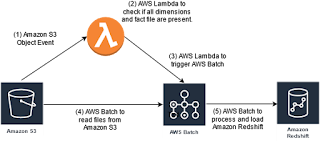Job Scheduling on AWS - Part 1 - Using AWS native services for job scheduling

In this blog, I will look at some of the ways to schedule and/or run job/batch-jobs in AWS using AWS native services. In Part 2 of the post, I will talk about how to extend your current on premise job schedule to AWS. 1) Using AWS Lambda – An AWS Lambda can be triggered via several ways. The most common way will be to trigger by a file upload to S3. Create your AWS Lambda function and set the trigger. Your trigger can be a file upload to S3. The moment a file is uploaded it executes the AWS Lambda which contains your execution code. Considerations for using AWS Lam bda – a. When processing large files use AWS Lambda as a trigger rather than a file processor. For example - lets say your requirement is to load fact and dimension files into Amazon Redshift, and you are using Amazon QuickSight to reports on Amazon Redshift. Considering the time and payload limits of AWS Lambda, a suggested architecture in this scenario would be to us